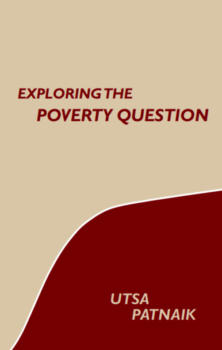Excerpted from Utsa Patnaik, Exploring the Poverty Question, Delhi: Tulika Books, 2025.

Utsa Patnaik
Exploring the Poverty Question
Tulika Books, 2025
The media have been full of claims by the World Bank and by individual governments that in the global South, ‘millions of people had been lifted out of poverty’ during the last four decades. India, by now the most populous country in the world, claimed that by 2022—23 only 5 per cent of its population was poor. The data on nutritional intake in India however show that hunger rose greatly for both rural and urban populations during the same period, while its very low ranking on the global hunger index worsened further. Even educated citizens believe the official claims and say, ‘how can hunger have increased when poverty has declined?’ The question however should be the other way round, namely, ‘how can poverty have declined when hunger has increased?’ The information on increase in hunger is far more direct and based on readily verifiable statistics, than are the official calculations of poverty. The latter are indirect and use certain calculation procedures—very strange and illogical ones as my book argues—to derive the results on which claims of poverty decline are based.
It was not always the case that illogical statistical procedures were used. Initially in every country using consumer expenditure surveys, the ‘poverty line’ was ascertained as the currently observed actual spending level per head at which the accepted nutrition norm was satisfied. The problem arose because for every subsequent estimate in every country, this definition of the poverty line was quietly abandoned; the nutrition norm was no longer applied to determine the correct current poverty line, and instead the original poverty line was simply updated to later years using a consumer price index. This meant holding unchanged for many decades, the particular basket of goods and services consumed in the original ‘base year’, which in India is over five decades in the past.
This is a fundamentally illogical method. We cannot adopt one definition of poverty line directly derived from nutritional intake in one year, term it the initial base year and then for later years switch to a completely different definition of the poverty line that is no longer directly linked to nutrition (even though current data on nutrition are available) but simply applies a price index to the base year line. This procedure embodies a fallacy, a mistake in reasoning. Logicians call it a ‘fallacy of equivocation’ where the same term—in this case, ‘poverty line’—is improperly used with two completely different meanings in the course of an argument. This fallacy has been routinely committed by governments and by the World Bank, not once or twice but repeatedly over many decades. We show that their poverty lines have ended up being cumulatively underestimated and have given access to lower and lower nutritional intake. The poor have been counted below a declining, not a constant standard over many decades, until the ultimate absurdity has been reached by now, when the official poverty lines are so low that they no longer permit human survival. Zero or very few observations because there are no survivors or hardly any survivors, is then perversely interpreted as zero poverty or very low poverty.
In the present study I have applied the original nutrition-based definition of poverty line, for the first time in the literature, to the basic data available in India from every five-yearly large sample survey carried out by the NSSO starting from 1978, with a more detailed treatment for the years from 1993-4 onwards. These true, nutrition- based poverty lines show rapid upward divergence from the official poverty lines especially during the period of neo-liberal reforms. At the All-India level the proportion of rural/urban persons unable to reach initial official nutrition norms of 2200/2100 daily calorie intake, rose from 56.4/49.2 percent during 1973-4 to 58.5/56 percent by 1993-4 and thereafter rose faster by 2011-12 to 67/62 percent. The nutritional intake data for 2017-18 have not been made directly available, but reasonable estimates based on “leaked data” show a peaking of rural deprivation with 80 percent unable to reach the nutrition norm. Thereafter the government has changed the method of data collection.
The official price indexation of a base year poverty line means applying a Laspeyres index, that is, it takes a fixed and unchanged consumption basket with respect to items and quantities consumed, for a base year that has receded into the distant past. But it is precisely the change in the initially available basket of goods that decides whether people remain poor, get poorer or get better off. Historically, poverty was reduced greatly or eliminated entirely by state policies in those countries where health care, education, and to a large extent housing and utilities were removed from the sphere of market pricing, and were treated as subsidized public goods. Thereby a large share of the average family budget could be devoted to purchasing food, manufactured necessities and on recreational activities. Such measures were not only typical in the socialist countries in Asia and in socialist economies in Europe as long as they existed, but were also undertaken after World War II in almost all the West European capitalist countries. The converse happened, the available basket of goods and services changed drastically with the introduction of neo-liberal market-oriented and export-oriented economic reforms in countries of the global South, starting in the 1990s in India and at varying dates elsewhere. These measures substantially removed health care, education and utilities from the category of public goods and into that of higher-cost market pricing. The small minority of the well-to-do were unaffected and in fact gained greatly from these reforms, but the income available to the majority of the population was reduced for basic spending on food and manufactured necessities.
It was argued by some that the prolonged fall in per capita cereal intake in India was nothing to worry about because with rise in per capita income it was only to be expected that people would diversify diets to superior foods. What they miss is that the data relate not just to the direct intake of foodgrains but to direct and indirect intake, the latter via animal products and processed foods. This total intake is invariably found to rise with real income, all over the world. The three decades of neo-liberal reforms in India however have seen a well-documented decline in real spending per capita on food, while from 2011 onwards we see a decline in real spending per capita on all goods and services. The nutritional intake data show a decline not only in energy intake per capita measured in kilocalories per day, but also in per capita protein intake per day. In short, poverty has risen substantially over the last three decades.
China’s recent assertion of achieving zero extreme poverty, was preceded years earlier by similar claims for many parts of India. The point, however, is that there cannot possibly be any observations of persons below official poverty lines measuring extreme poverty, for these official poverty lines are so low that at these poverty lines, people can no longer physically survive. This observation applies to China as well for reasons discussed in the book. The daily poverty line for all spending needs, both food, non-food and services, for rural/urban India in 2022-23, at which the Niti Aayog claimed that only 5 percent of the population was poor, were Rs.59/69, sums which would allow at most 3/3.5 litres of water to be bought. The poor do not actually buy packaged water; the example is to show just how meagre the poverty line is. The current official claim that only 2 percent of the population is in poverty arises from further indexation and lowering of the nutrition accessible, so that there are hardly any survivors.
By delinking the estimation procedure from the nutrition norm, the very concept of poverty-line was violated, to a greater extent every time. For example, the 2011 official rural poverty ratios in in Goa and Gujarat were 6.8 percent and 21.5 per cent respectively, but at the poverty lines producing these ratios, only 1570 calories and 1668 calories could be accessed daily. The actual populations in poverty, unable to reach the 2200 calories norm, were 81.5 percent and 87 percent respectively.
Not a single publication whether by the Planning Commission (now Niti Aayog) or by the World Bank, or by individual academics using the official procedure, ever mentions the blatantly obvious fact of sharply declining nutritional intake accessible at successive official poverty lines—a fact that makes their estimates spurious. This suppression of fact was expedient on the part of governments, the World Bank and their economists, for it allowed them to claim spurious poverty reduction during the period of neo-liberal reforms that they promoted and implemented.
I had warned in a 2013 paper that soon the logically incorrect official method would lead to spurious claims of zero poverty, and that indeed has come to pass. What can be more illogical and absurd than to take a 50-year-old consumption basket, arrive at current ‘poverty lines’ that are so low that people can no longer physically survive at these levels, and then interpret the fact of no observations because there are no survivors, triumphantly as the achievement of ‘zero poverty’. The elaborate structure of false statistical claims needs to be dismantled in every country. Only then can there be an honest attempt to chart a way forward to end poverty.

